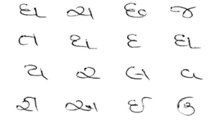Abstract
This paper describes a system for recognizing offline handwritten Tamil characters using support vector machine (SVM). Data samples are collected from different writers on A4 sized documents. They are scanned using a flat bed scanner at a resolution of 300 dpi and stored as gray-scale images. Various preprocessing operations are performed on the digitized image to enhance the quality of the image. Pixel densities are calculated for 64 different zones of the image and these values are used as the features of a character. These features are used to train the SVM. The SVM is tested for the first time to recognize handwritten Tamil characters. The system has achieved a very good recognition accuracy of 82.04% on the handwritten Tamil character database.





Similar content being viewed by others
References
Pal U, Chaudhuri BB (2004) Indian script character recognition: a survey. Pattern Recognit 37:1887–1899
Mantas J (1986) An overview of character recognition methodologies. Pattern Recognit 19(6):425–430
Govindan VK, Shivaprasad AP (1990) Character recognition—a review. Pattern Recognit 23(7):671–683
Srihari SN, Yang X, Ball GR (2007) Offline Chinese handwriting recognition: an assessment of current technology. Front Comput Sci China 1(2):137–155
Lorigo LM, Govindaraju V (2006) Offline Arabic handwriting recognition: a survey. IEEE Trans Pattern Anal Mach Intell 28(5):712–724
Gatos B, Ntzios K, Pratikakis I, Petridis S, Konidaris T, Perantonis SJ (2006) An efficient segmentation-free approach to assist old Greek handwritten manuscript OCR. Pattern Anal Appl 8:305–320
Jaeger S, Nakagawa M, Liu C-L (2002) A brief survey on the state of the art in on-line handwriting recognition for Japanese and western script. Tech Rep IEICE 101(713):1–8
Vasantha Lakshmi C, Patvardhan C (2004) An optical character recognition system for printed Telugu text. Pattern Anal Appl 7:190–204
Siromoney G, Chandrasekaran R, Chandrasekaran M (1978) Computer recognition of printed Tamil character. Pattern Recognit 10:243–247
Chinnuswamy P, Krishnamoorthy SG (1980) Recognition of hand printed Tamil characters. Pattern Recognit 12:141–152
Suresh RM, Ganesan L (1999) Recognition of hand printed Tamil characters using classification approach. ICAPRDT, Kolkata, pp 63–84
Hewavitharana S, Fernando HC (2002) A two stage classification approach to Tamil handwriting recognition. In: Tamil Internet 2002, California, USA, pp 118–124
Bhattacharya U, Ghosh SK, Parui SK (2007) A two stage recognition scheme for handwritten Tamil characters. In: Proceedings of the ninth international conference on document analysis and recognition (ICDAR 2007). IEEE Computer Society, Washington, DC, pp 511–515
Sutha J, Ramaraj N (2007) Neural network based offline Tamil handwritten character recognition system. In: Proceedings of the international conference on computational intelligence and multimedia applications, vol 2. IEEE Computer Society, Washington, DC, pp 446–450
Shanthi N, Duraiswamy K (2005) Preprocessing algorithms for the recognition of Tamil handwritten characters. In: Third international CALIBER 2005, Kochi, pp 77–82
Casey RG, Lecolinet E (1996) A survey of methods and strategies in character segmentation. IEEE Trans Pattern Anal Mach Intell 18(7):690–706
Plamondon R, Srihari SN (2000) On-line and off-line handwriting recognition: a comprehensive survey. IEEE Trans Pattern Anal Mach Intell 22(1):63–84
Otsu N (1979) A threshold selection method from grey level histogram. IEEE Trans Syst Man Cybern 9(1):62–66
Lam L, Lee S-W, Suen CY (1992) Thinning methodologies—a comprehensive survey. IEEE Trans Pattern Anal Mach Intell 14(9):869–885
Trier ØD, Jain AK, Taxt T (1996) Feature extraction methods for character recognition—a survey. Pattern Recognit 29(4):641–662
Boser BE, Guyon IM, Vapnik VN (1992) A training algorithm for optimal margin classifiers. In: Proceedings of the fifth annual workshop on computational learning theory, July 27–29, ACM, New York
Christopher Burges JC (1998) A tutorial on support vector machines for pattern recognition. Data Min Knowl Discov 2(2):21–67
Author information
Authors and Affiliations
Corresponding author
Rights and permissions
About this article
Cite this article
Shanthi, N., Duraiswamy, K. A novel SVM-based handwritten Tamil character recognition system. Pattern Anal Applic 13, 173–180 (2010). https://doi.org/10.1007/s10044-009-0147-0
Received:
Accepted:
Published:
Issue Date:
DOI: https://doi.org/10.1007/s10044-009-0147-0




